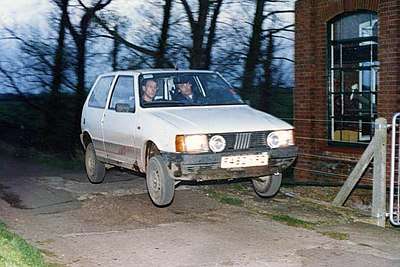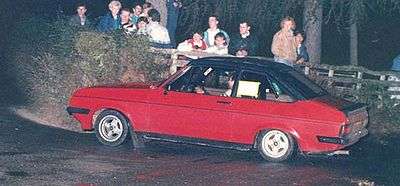Road rally
A road rally is a car rally that takes place on the public road. It is a popular sport in the United Kingdom, especially Wales, and has traditionally been the core of the "grass roots" of club-based amateur motorsport. However it has declined in popularity since the 1980s and now stage rallies are probably generally more popular with amateurs. A very similar sport is the 12-car rally, which runs to broadly the same rules.

The attraction of the sport is that it is very cheap to compete, requiring relatively small levels of preparation, and is open to a wide degree of abilities. Its disadvantages are that for safety reasons they have to be run in very remote (generally rural) areas, and late at night. One reason for their decline has been the reduction in areas available for running the events, and the increasing burden on organisers to ensure that the rally will not cause a nuisance to any residents affected. There has also been a considerable number of rule changes since 1988 designed to reduce vehicle speeds, which has not been a popular development with some competitors.
History
Historically, all rallies were once road rallies. Gradually, events started to include a number of "special" stages which were often run off-road. In time these special stages started to comprise the majority of events, and as rallying became faster and more of a recognised sport, the number of competitive stages run on the public road dropped to zero. Thus stage rallying became the main form of rally as recognised by most people today. However, road rallies did not go away, but they became less attractive to commercial interests, and so became the amateur sport that still exists today. Because of their heritage, and in spite of efforts by some lobbyists, the sport remains fully legal and regulated by the sport's governing body, the Motor Sports Association. Note that some stage rallies are run on the public roads in many places, but the key distinction here is that such roads are closed to the public for the duration of the event. In the UK, however, closed roads are only available on the Isle of Mull, the Scottish Borders, and Northern Ireland. In Ireland and the Isle of Man, however, roads are routinely closed for sanctioned stage events. Road Rallies by contrast run competitively on the public road, but these are not closed to the public. Conflict is minimised by using rural roads very late at night (many events don't start until midnight).
In a road rally, competitors compete over a predetermined course against the clock. Cars start at (usually) one-minute intervals. There is no direct head-to-head racing, and these days the emphasis is very much on navigation and teamwork rather than out-and-out speed. In theory, organisers of road rallies design the course so that no rules of the road need to be broken in order to compete, but in practice there is often a degree of transgression by competitors; in the past this has caused some difficulties for the sport.
Before 1988 (see below) most events specified a "bogey time" for each competitive section, or "selective", in the rallying jargon. This was a time set for the section, that, if achieved, would result in no time penalty being applied. Bogey times were usually calculated to be impossible, or just barely possible to achieve, and in doing so, would require speeds vastly in excess of the speed limit. The theory was that nobody would achieve these times, so in theory nobody would necessarily be breaking the law - and of course the organisers would be easily able to determine the running order of the finishers. The problem was that in practice cars had become so highly developed (and the bogey time concept gave them a strong incentive to do so) that bogey times were regularly being achieved, leading to shorter bogey times, and ever higher speeds.
1988 changes
In the mid-1980s, road rallies were starting to cause a good deal of concern for the police and others, who felt that speeds had become too high. At this time, road rallying was still very much based on speed and driving skill with much less emphasis on the navigation than there is today. A variety of proposals were discussed in the motorsport press for a number of years about how to address these concerns while keeping the sport viable. These included a proposed maximum engine capacity limit. In the meantime, cars were being prepared to an ever-greater degree and speeds were rising. Commercial sponsorship was permitted and despite the sport's relatively low profile, many of the top crews did acquire sponsorship. Police started to monitor events more closely, and in a series of highly publicised 'fact finding' episodes, revealed that some cars had been regularly 'clocked' travelling at over 120 mph (190 km/h), and in one case, 150 mph (240 km/h) on rural country lanes. While the police made no arrests regarding this, they did voice their concerns publicly and insisted that the MSA do something about it. Proponents of the sport argued that the police's case was weak, since in practice accidents were extremely few, and where they did occur rarely involved members of the public not involved in the event. Third-party property damage was already fully insured under the existing rules. Injuries were extremely uncommon, since most cars featured the same safety devices (roll cage, full harnesses, firewalls, etc.) as fully prepared stage rally cars. Insurance for competing crews was cheap and easy to obtain, reflecting the good safety record of the sport.
In 1988, the rule changes came into force, dramatically affecting the popularity of the sport, though largely achieving the police's aims at reducing speeds. These changes included:
- No signwriting or other "motorsports" decals on the vehicles, except for the organisers' rally plates (this effectively removed commercial sponsorship from the sport).
- Rally plates to be small (30 cm x 10 cm approx) showing the event name and competitor number only
- "Bogey times" outlawed
- Targa timing banned - all events must be timed using ordinary time of day (this rule gives greater accountability for the speeds set for the event)
- A maximum average speed of 30 mph for every section of the course
- "Preplot" route information outlawed except for forbidden zones ("blackspots") and essential safety information
- Maximum four cylinder engine permitted
- Fuel injection only allowed where fitted as standard
- New rules regarding maximum tyre and wheel sizes
- Signature of awareness from all residents affected by a route to be obtained in order to obtain an event permit
- All route information to be submitted and approved by the police prior to the event
- Stricter noise level limits

While these changes were not as draconian as many had feared (for example, one of the most popular cars for road rallies at this time was the Mk II Ford Escort, usually fitted with a 2-litre+ high performance engine - many thought these would be banned in favour of a maximum capacity limit of 1300cc or even 1100cc), the changes had a dramatic impact. The loss of targa timing for example meant that organisers were forced to make the navigation much more difficult, and by eliminating preplot (decoding and plotting all route information prior to the start) in favour of so-called "plot 'n' bash" navigation, shifted the focus of the competition onto the navigation. This did not eliminate the high driving speeds since once the route was deciphered and plotted, it had to be driven - and the route plotting was now "against the clock" too. Another device to achieve the 30 mph rule was to use much tighter, twistier routes and green lanes (known in some areas as "whites", since such roads appear as white roads on Ordnance Survey Landranger maps) that could not be driven at high speed. Despite this, speeds were still high, and organisers developed a number of methods whereby the new rules were met, but some of the flavour of the older style events was retained (e.g. "restart" sections where competitors were held in a queue for a time in order to allow the slower crews to catch up - this dead time counted towards the overall 30 mph average, thus the rest of the rally could proceed at a higher speed without breaking the rules). Note that a 30 mph average is still quite high when the type of roads used is considered, especially as this average includes non-competitive link sections that may be timed at a very low average, such as 15 or 20 mph. However, with the elimination of commercial sponsorship, less money came into the sport and over time this affected the degree to which cars were able to be prepared by the average competitor. Many of the top road rally crews quickly moved into stage rallies - notable among them was one time Welsh road-rally demon Gwyndaf Evans.
Notable events (past and present)
- 1000 Lanes Road Rally (organised by Heads of the Valleys Automobile Club)
- Autumn Rally (organised by Carmarthen Motor Club)
- Barcud Road Rally (organised by Barcud Motor Club)
- Border 100 Road Rally (organised by Welsh Border Car Club)
- Bolton Midnight Rally (an old Motoring News round revived in 2005)
- Breidden Road Rally (organised by Welsh Border Car Club)
- Bullrun[1]
- Carpetbagger Rally
- Classic Tracks Road Rally (organised by Llandysul Motor Club)
- Eagle Road Rally (organised by Newtown and District Automobile Club)
- Gremlin Road Rally (organised by Brecon Motor Club)
- goldRush Rally[2]
- Gumball 3000
- Hoka Hey Motorcycle Challenge
- Justice Road Rallies[3]
- The Land's End to John o' Groats Reliability Trial
- Life in Sixth Gear (LSG Rally)[4]
- Motoring News Road Rally Championship[5]
- Night Owl Road Rally (organised by Aberystwyth and District Motor Club)
- Pacemaker Road Rally (organised by Knighton Motor Club)
- Peak Revs Road Rally (organised by Ludlow Castle Motor Club)
- PK Memorial Road Rally (organised by Bala and District Motor Club)
- Powys Lanes Road Rally (organised by Epynt Motor Club)
- Rali Bro Caron (organised by Lampeter and District Motor Club)
- Rali Bro Ddyfi (organised by Dovey Valley Motor Club)
- Rali Cilwendeg (organised by Teifi Valley Motor Club)
- Rali Llyn (organised by Harlech and District Motor Club)
- Rali Meirion (organised by Harlech and District Motor Club)
- Rali Mike Darowen (organised by Dovey Valley Motor Club)
- Rali Mon (organised by Caernarvonshire & Anglesey Motor Club)
- Rally North America[6]
- Rental Car Rally
- Sarn Helen Road Rally (organised by Lampeter and District Motor Club)
- Targa Rusticana
- Ystwyth Road Rally (organised by Aberystwyth and District Motor Club)
See also
References
- "Bullrun: Rallying the World -". Bullrun: Rallying the World.
- "goldRushRally – The Road Less Traveled".
- "Justice Road Rallies - Calgary's Low Cost Road Rally". Justice Road Rallies.
- "Archived copy". Archived from the original on 2018-08-05. Retrieved 2020-05-02.CS1 maint: archived copy as title (link)
- http://www.mnrrc.co.uk Archived 2014-05-16 at the Wayback Machine
- "Rally North America | Get In And Drive!".